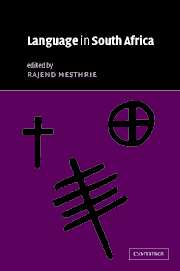Book contents
- Frontmatter
- Contents
- List of maps
- List of contributors
- Acknowledgements
- List of phonetic symbols
- List of abbreviations
- Introduction
- Part I The main language groupings
- Part II Language contact
- 9 Fanakalo: a pidgin in South Africa
- 10 Mutual lexical borrowings among some languages of southern Africa: Xhosa, Afrikaans and English
- 11 Code-switching, mixing and convergence in Cape Town
- 12 Code-switching in South African townships
- 13 Intercultural miscommunication in South Africa
- 14 Women's language of respect: isihlonipho sabafazi
- 15 The sociohistory of clicks in Southern Bantu
- 16 The political economy of language shift: language and gendered ethnicity in a Thonga community
- 17 From second language to first language: Indian South African English
- 18 Black South African English
- 19 The lexicon and sociolinguistic codes of the working-class Afrikaans-speaking Cape Peninsula coloured community
- 20 An Introduction to Flaaitaal (or Tsotsitaal)
- 21 Language and language practices in Soweto
- Part III Language planning, policy and education
- Index
- References
17 - From second language to first language: Indian South African English
from Part II - Language contact
Published online by Cambridge University Press: 22 September 2009
- Frontmatter
- Contents
- List of maps
- List of contributors
- Acknowledgements
- List of phonetic symbols
- List of abbreviations
- Introduction
- Part I The main language groupings
- Part II Language contact
- 9 Fanakalo: a pidgin in South Africa
- 10 Mutual lexical borrowings among some languages of southern Africa: Xhosa, Afrikaans and English
- 11 Code-switching, mixing and convergence in Cape Town
- 12 Code-switching in South African townships
- 13 Intercultural miscommunication in South Africa
- 14 Women's language of respect: isihlonipho sabafazi
- 15 The sociohistory of clicks in Southern Bantu
- 16 The political economy of language shift: language and gendered ethnicity in a Thonga community
- 17 From second language to first language: Indian South African English
- 18 Black South African English
- 19 The lexicon and sociolinguistic codes of the working-class Afrikaans-speaking Cape Peninsula coloured community
- 20 An Introduction to Flaaitaal (or Tsotsitaal)
- 21 Language and language practices in Soweto
- Part III Language planning, policy and education
- Index
- References
Summary
INTRODUCTION
Indian South African English (henceforth ISAE) is worthy of the attention of sociolinguists and scholars concerned with new Englishes, for a variety of reasons. It offers the opportunity of examining in a relatively fossilised form (on account of former rigid segregative tendencies in South Africa) the evolution of a dialect of English under less than perfect conditions concerning educational and social contact with target-language speakers. It also provides, again in a relatively fossilised form, the opportunity of studying the changes a language undergoes as it shifts from L2 to L1.
This chapter has two aims: (a) to complete the sociohistorical background to language maintenance and shift among Indian South Africans begun in the article on Indian languages (chap. 8, this volume); and (b) to examine the consequences of social history on linguistic and sociolinguistic structure, manifest in the dialect of English spoken by Indians in KwaZulu-Natal.
As a prelude to the history of ISAE the reader is referred to the background of indenture and immigration set out in chapter 8. Historical records suggest that the vast majority of Indian immigrants (perhaps 98 per cent –see Mesthrie 1992b: 12) had no knowledge of English. The language of the new colony that Indians learnt quickest was the pidgin, Fanakalo. For communication among themselves Indians used an Indian language (usually Bhojpuri or Tamil) and sometimes Fanakalo. Generally, the use of English among Indians in nineteenth-century Natal was the exception rather than the rule.
- Type
- Chapter
- Information
- Language in South Africa , pp. 337 - 355Publisher: Cambridge University PressPrint publication year: 2002
References
- 2
- Cited by



